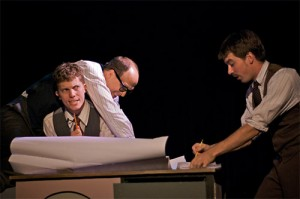Chances are you're familiar with Raymond Scott's music... you just don't know it. The 20th-century American electronic music pioneer composed many of what became animation's most infamous tunes, even though he didn't write them with Bugs Bunny in mind.
Director Jon Levin was humming one of Scott's melodies, "
Powerhouse," when a friend described how, despite his recognition for cartoon soundtracks---among them a host of
Looney Tunes classics, as well as contemporary series like
The Ren & Stimpy Show,
Animaniacs, and
The Simpsons---he constantly strove to create a newer and faster kind of music. It was only because Scott sold his publishing rights to Warner Bros. that cartoon production teams were able to license his work, bringing him success he never actually looked for.
"There was something compelling about the idea of someone who wanted to do one thing [and] was recognized for something else entirely," says Levin. "The fact that it was undermined by cartoons had a strong theatrical metaphor."
Driven by that concept, Levin and his collaborator Josh Luxenberg, who co-head the ensemble Sinking Ship Productions, created
Powerhouse, a lively exploration of Scott's life. (It plays at the New Ohio Theatre through Nov. 23.)
With his abundance of quirks, from funny turns of phrase to curious flirtation tactics, as well as his journey from well-known composer to forgotten artist, Scott by himself is rich fodder for the theatre. Sinking Ship goes a few steps further, however, by including tales about his three wives and narratives about various animators. "While Scott changes his focus from jazz, to machines---so that he can get closer to making the sounds in his head---we follow the animators as they develop characters and these stories collide," Levin says.
The company uses puppets to capture the unique physics of cartoons onstage. At one point, for instance, the audience sees animators brainstorm about a character. "They make a puppet out of the thrown away paper scraps," says Levin. "The next time we see the character, there is an assembly line sequence, and the character is built as a puppet."
The group agreed that table top puppetry, where the puppeteer is in plain view, best represents cartoon movement while also calling attention to the creator. That doubling effect---of a visible puppet and puppeteer---prompts the audience to think about both the cartoon character and the human being breathing life into it.
"Table top puppetry lets us be precise and dynamic in the puppet's movements so that it captures a cartoon style in a way that marionettes or even hand and rod puppets would not have allowed us to achieve," says Levin.
Beyond the myriad characters at play, Luxenberg points out that Scott's life spanned much of the 20th century. So in telling his story,
Powerhouse also explores the evolution of technology itself. "Scott was making music in the 1930s and inventing electronic music in the 50s and 60s through to the 80s. He invented machines that made this kind of music possible. There are these moments in his life where you feel that drive through the 20th century."
---
Eliza Bent is a journalist and editor based in Brookyln
Photo by Josh Luxenberg